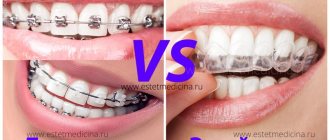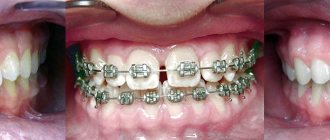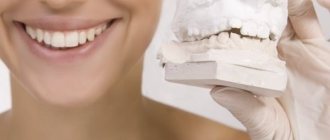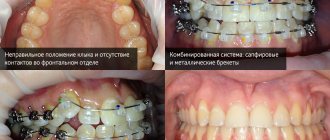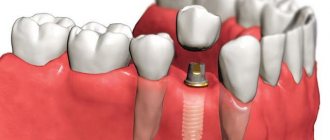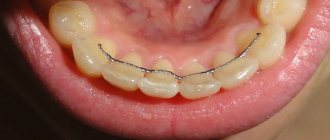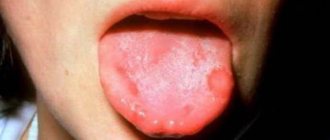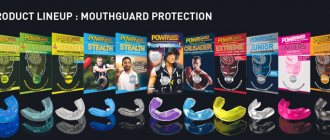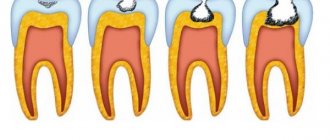We reveal the veil of secrecy: how long you need to wear a retainer and which one is better to choose
Wearing braces is not the last stage of orthodontic treatment. After removing the corrective device, the so-called retention period begins. This means that the doctor prescribes retainers, which are necessary to consolidate the achieved results. For this purpose, a special non-removable structure can be installed or, for example, special mouthguards can be prescribed. For more information about what retainers are, why they are needed, why they are placed after braces, and how long they need to be worn, read further in the article.
What are retainers used for?
Contraindications as an additional argument for choosing the type of retainer
The type of retainer or trainer to be installed is selected based on the specific clinical situation. The patient can express his wishes, but the dentist has the final say. Additionally, when choosing a design, consider contraindications for wearing fixed systems:
- disorders of salt or mineral metabolism;
- tendency to rapid stone formation - especially important for patients who smoke, neglect hygiene, and have a sweet tooth;
- gum disease, wedge-shaped defect, carious lesions of teeth;
- the presence of tumors in the oral cavity;
- metal allergy;
- the structure of the oral cavity, in which the ligature will injure soft tissues.
Retainers are removable and non-removable.
Important! Most contraindications are relative. Wearing a non-removable structure is possible after appropriate treatment.
Removable systems cannot be worn in only one case - an allergy to the material. But it is observed rarely - in 2-3% of patients.
A combined method is often recommended for the recovery period. A fixed structure is placed on one jaw, and a removable one on the other. It is also recommended to have a spare model in reserve in case the main one breaks or comes off.
What are they and for what purposes are they installed?
A retainer is a special design that is used after braces are removed in order to consolidate the achieved treatment results. They are necessary to fix the aligned teeth in the correct angle, so that they do not gradually return to their initially incorrect position. Many people are concerned about how long they need to wear retainers and whether they interfere with eating or talking. The duration of the retention period usually takes about half the time it took to correct it with a brace system.
The retainer can be a non-removable wire structure, which is fixed on the back side of the row, as well as a transparent mouthguard or an orthodontic plate. According to patient reviews, the retention period is characterized by minimal discomfort, and in the case of flat, non-removable systems, no inconvenience is felt at all. Thus, when answering questions about why retainers are needed and whether it is necessary to install them, it should be noted that without them, the teeth will soon return to their original position, and long-term, expensive treatment will lose all meaning.
Types of designs and their differences
Today in dentistry, there are two main types of retention systems for straightening teeth: those that need to be removed before eating and while brushing your teeth, and those that are fixed with glue and are not intended for self-removal. The choice in favor of one or another type of structure is made by the orthodontist, based on the existing clinical picture. Let's look at these two varieties in more detail.
Removable structures
Such devices can be removed independently, for example, while eating, or worn constantly, depending on the instructions of the attending physician. Some models need to be worn only while sleeping, others are indicated for wearing during the day. A serious approach on the part of the patient is important here. Such retainers should not be removed too often, otherwise the entire treatment may go down the drain.
The photo shows a removable mouthguard
“I had this happen. As I got older, my teeth began to move apart, so I had to get braces. The treatment took about a year, but after the system was removed, I was prescribed clear aligners. I had to go with them for another year. It is important to wear them constantly, otherwise all your teeth will creep back. But I would argue about comfort - they are not that comfortable.”
Evgeniy V.K., Saratov, from correspondence on the forum www.32top.ru
This can be a correction plate with a polymer or plastic base, a metal arch and a spring, as well as a transparent mouthguard or a special orthodontic mask1. Such designs do not cause much discomfort and do not injure the mucous membrane, since they are devoid of sharp protruding parts. More often they are prescribed to hold teeth in the desired position in the upper jaw.
Fixed retainers
To understand what a permanent metal retainer looks like, just imagine a thin wire arch or flat tape, which is attached to the inside of the row using special glue. This design is often installed on the lower jaw, and also usually involves long-term wear with periodic visits to a specialist. The product has a constant impact on the row, preventing it from moving, and this is an undeniable advantage of the non-removable structure. On the other hand, the presence of even a thin wire in the mouth makes it somewhat difficult to carry out hygienic procedures - regular professional cleaning in the dentist’s office is required.
On a note! Many people are concerned about whether it is possible to do an MRI if there are braces or a metal retainer in the mouth. In this case, the procedure is allowed, but much will depend on which particular area you need to undergo examination. If you plan to do an MRI of the brain or cervical vertebrae, the information may be distorted, but examination of other parts of the body should proceed without any interference. The material of the braces also plays a big role - as a rule, modern metals do not cause distortion. But in any case, you need to consult a specialist.
The photo shows a permanent retainer.
In some situations, several types of systems are combined, for example, a mouth guard is installed on the top row, and a wire structure is installed on the bottom row. In other cases, to begin with, the patient is fixed with a non-removable retainer, and after some time it is removed and replaced with a removable plate. It all depends on the characteristics of the clinical picture and the individual characteristics of the patient’s body.
Installation Features
Choosing the right retainer does not happen at random. First, the specialist evaluates the result of the impact of the braces, and then selects which retainer should be installed. Typically, removable devices are installed when teeth have been removed during treatment.
The main task of the devices is to ensure a fixed position of the dentition, without displacement towards the removed ones. The installation process itself is not complicated. The devices are simply placed on the desired jaw or both at once.
When choosing a retainer, experts do not pay attention to the absence of wisdom teeth, since they do not affect the bite. Before installing fixed structures, the oral cavity is thoroughly prepared.
Upon examination, a specialist identifies damaged teeth that require treatment. They also prepare tooth enamel and remove plaque. When using a combined device, a non-removable arch is put on the upper row of teeth, and a mouthguard is put on the lower row.
The devices are almost invisible, as they are installed on the inside of the jaw. After six months, it is advisable to visit a specialist to check the state of teeth fixation. If the need arises, the old retainer is replaced with a new one.
What are the pros and cons
| Advantages | Flaws |
| Fixed retainers | |
|
|
| Removable systems | |
|
|
Advantages and disadvantages
The devices have a large number of advantages compared to other manufacturers of transparent retainers of this class:
- the aesthetics of the device eliminates discomfort when communicating and smiling;
- quickly and easily adapts to the anatomical features and structure of the dentition;
- the natural mobility of the teeth is not hampered , and the fixation is quite tight;
- variability , that is, the product can be made for both the upper and lower jaw arches;
- ease of use - putting on and taking off the device is quite simple;
- multifunctionality - the device makes it possible to adjust the dentition if necessary;
- sufficiently high effectiveness of treatment is guaranteed;
- Maintenance of the structure requires a minimum of effort : it is enough to rinse it under running water.
However, removable Osamu models also have significant disadvantages:
- During installation, slight discomfort and unclear diction are possible; slight adaptation to the design will be required;
- in some cases, irritation of the oral mucous tissues is possible;
- hypersalivation (excessive salivation) may occur.
In addition, when using a retainer, there is a need to regularly visit the dentist to record the effectiveness of the retention process.
How does the installation process work?
Now let's talk about how dental retainers are installed. Obviously, the installation process will directly depend on the type of structure used. Thus, installing mouth guards or a removable plate is not particularly difficult - the doctor fixes the system on the teeth, showing the patient how to do it correctly, and also explains how to wear the device and when it can be removed. Fixing a permanent wire structure may take a little longer. The process includes the following steps:
- removal of braces and examination of the patient’s oral cavity to assess the effectiveness of treatment and selection of a retention system,
- elimination of carious processes and other dental diseases that arose during treatment,
- carrying out hygienic cleaning,
- treating enamel with a special solution for adhesion,
- drying the surface and slightly preparing it so that the wire or tape can be securely glued,
- fixation of the system with dental glue.
The photo shows the installation of a non-removable retainer.
Installing a permanent retainer is a quick and completely painless process for the patient. The procedure does not require the use of anesthesia and takes literally 10-15 minutes.
Price
The range in prices for retainers in Moscow clinics is quite large. The cost starts from 1,000 rubles (in budget clinics) and ends at around 15,000 rubles (in private centers). This factor depends on the dental policy and type of design.
| Type | Price in rubles |
| Fixed wire | 6 000 – 8 000 |
| Fixed wire with aesthetic arch | 9 000 – 13 000 |
| Removable retention plate | 7 500 – 12 000 |
| Kappa | 5 000 – 9 000 |
| Trainer | 12 000 – 15 000 |
The cost of the design depends on the pricing policy of the clinic and the type of product.
Important! The clinic needs to clarify whether installation, removal and maintenance of the retainer is included in the price.
How long will you have to wear the structure?
Most often, patients are concerned about the question of how long such structures are usually worn. It is quite difficult to give a definite answer on this matter. The duration of the retention period is determined only after removal of the previous structure. So, for example, a mouthguard or plate will have to be worn for at least two periods of wearing braces. Fixed wire retainers are often fixed for life. Everything here is very individual, and only an orthodontist can determine the duration of the final stage of treatment.
Is it possible to remove the wire yourself?
Another popular question regarding the retention period is related to how the wire structure is removed and whether it can be done independently. It is immediately necessary to make a reservation that only a specialist can do this in a clinical setting, and he also determines the duration of wearing the structure, as well as the advisability of replacing it with another type of corrective device. The removal procedure takes 10-15 minutes. First, the doctor carefully cuts the wire using a special tool, and then peels off the fixing elements. The remaining polymer composition is removed from the enamel and the cleaned surface is polished. You cannot remove the fasteners yourself, as this can seriously injure the enamel.
Some tips for care
As we have already found out, after correcting the bite and position of the teeth in a row, retainers are fixed, which also require regular cleaning. Below are important tips from orthodontic experts on how to care for your mouth during the retention period and how to clean fixed appliances:
- You should brush your teeth at least twice a day; for more thorough cleaning, it is better to purchase a special brush and irrigator,
- when processing enamel from inside the row, you should control the pressing force of the brush so that the wire does not come off,
- every time after eating you need to thoroughly rinse your mouth with plain water or a special pharmaceutical product,
- You should visit your dental hygienist's office every six months for a professional cleaning.
Oral hygiene should be more careful.
As for removable appliances, they need to be removed from the mouth every time before eating, and also placed in a disinfectant solution twice a day. The patient should have no doubt about whether retainers are needed - they are definitely necessary, since without them the whole treatment can go down the drain. The first couple of days after installation, you may experience some discomfort, but it quickly goes away on its own, without outside help. If the unpleasant sensations only become stronger, you need to urgently consult your doctor - perhaps the structure has failed or was initially installed incorrectly.
- Airapetova Ya.G. The use of a combination of removable mechanical devices and elastopositioners in children with dentition anomalies, 2008.
Are retainers always necessary?
Of course, no one will be happy with the prospect of continuing to endure the inconvenience of retainers after the braces system. Therefore, the question naturally arises: maybe we can try to do without them? It is especially difficult to convince a patient who sees a dazzling, even smile in the reflection of the mirror and does not understand what is wrong. But it is necessary to convince others, because retainers are always required.
Correction of dental bite
In patients over 30 years of age, the retention period varies from 2 to 5 years. If you wear retainers less, relapse is inevitable.
Malocclusions do not occur just like that; there is some reason that caused a change in the position of the teeth. In most cases, this is a genetic predisposition, which, unfortunately, cannot be corrected.
Therefore, the teeth will strive to take their previous position, and the still fragile bone tissue will not be able to interfere with this. Without retainers, relapse can occur very quickly, within just a few weeks.
